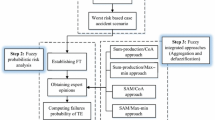Abstract
For chemical process normal operation, alarm systems play a critical role in industry to meet the demands of safety, quality and efficiency. However, a serious problem exists in industry: too many alarms raising shortly need to be handled by the operator. In this situation, appropriate alarm priority is extremely important, that is, the more important alarms at any given time are obvious to the operator, and this helps the operator to decide which alarms to deal with when several occur at the same time. Typically, the method to prioritize alarms is based on the severity of the consequences and the time available for the alarm, which depend on the operator’s experiences highly. Herein, a half quantitative alarm priority analysis is proposed to make alarm priorities more reliable and effective. Event tree analysis (ETA) is used to assess the risk consequence when an alarm occurs. ETA is one of quantified risk assessment techniques and is used for identifying and evaluating the sequence of events in a potential accident scenario following the occurrence of an initialing event. Finally, a case study is given to prioritize alarms using the algorithm that we introduce above, and illustrates the advantages of this algorithm through an example of an industrial application.









Similar content being viewed by others
Abbreviations
- FIAL2001:
-
Low flowrate of fuel gas
- PIAH1031:
-
High pressure of crude stabilizer
- R:
-
The risk of alarm
- S1:
-
The severity of “Minor Consequence”
- S2:
-
The severity of “Severe Consequence”
- AM:
-
Alarm management
- BPCS:
-
Basic Process Control System
- ETA:
-
Event tree analysis
- PSV:
-
Pressure safety valve
- SIS:
-
Safety Instrumented Systems
References
CCPS/AIChE (1993) Guidelines for engineering design for process safety. Wiley, New York: Center for Chemical Process Safety/American Institute of Chemical Engineers
Crowl DA, Louvar JF (2002) Chemical process safety: fundamentals with applications, 2nd ed. Prentice Hall, Upper Saddle River
EEMUA (2007) Alarm systems: a guide to design, management and procurement, 2nd edn. EEMUA Publication No. 191 Engineering Equipment and Materials Users’ Association, London
Ericson CA II (2005) Hazard analysis techniques for system safety. Wiley, Hoboken
Folmer J, Vogel-Heuser B (2012) Computing dependent industrial alarms for alarm flood reduction. Paper presented at: International Multi-Conference on Systems, Sygnals & Devices; 20-23 March 2012; Chemnitz, Germany. http://ieeexplore.ieee.org/document/6198008/
ANSI/ISA (2009) Management of alarm systems for the process industries. International Society of Automation, Research Triangle Park
Jun C, Chang S, Hong Y et al (1999) A Bayesian approach to prediction of system failure rates by criticalities under event trees. Int J Prod Econ 60:623–628
Sedek AB (2011) Alarm management-a practical approach for KBB project. In: The 1st Hazards Asia Pacific symposium, Sep 27-29, Kuala Lumpur, Malaysia
Stauffer T, Sands NP, Dunn DG (2010) Alarm management and ISA-18. A journey, not a destination. In: 65th Annual Instrumentation Symposium for the Process Industries, January 26–28 , Texas A&M University, Houston, TX, USA
Takai T, Kutsuma Y, Ishihara H (2012) Management of alarm system for process industries. Paper presented at: 2012 Proceedings of SICE Annual Conference (SICE); 20-23 Aug. 2012; Akita, Japan. http://ieeexplore.ieee.org/document/6318526/
Wang J, Yang F, Chen T, Shah SL (2016) An overview of industrial alarm systems: main causes for alarm overloading, research status, and open problems. IEEE Trans Autom Sci Eng 13(2):1045–1061. https://doi.org/10.1109/TASE.2015.2464234
Funding
The financial support from the National Natural Science Foundation of China (Grant No. 21706220) and scientific research starting project of SWPU (Grant No. 2017QHZ017) are gratefully acknowledged.
Author information
Authors and Affiliations
Corresponding author
Rights and permissions
About this article
Cite this article
Dai, Y., Qiu, Y. Risk Matrix and Event Tree Based Half Quantitative Alarm Priority Analysis for Alarm Systems. Process Integr Optim Sustain 3, 159–166 (2019). https://doi.org/10.1007/s41660-017-0026-x
Received:
Revised:
Accepted:
Published:
Issue Date:
DOI: https://doi.org/10.1007/s41660-017-0026-x




